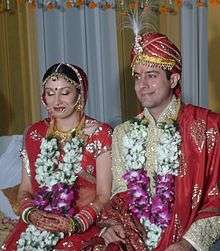Vedic wedding ceremony
Vedic wedding ceremony is that form of marriage prescribed in the Vedas and the Sutras in which the bridegroom (a virtuous learnt person) is invited and is respectfully married to a maiden.The bride-groom and the maiden belonging to different paternal lineages (Gotras) give birth to excellent children to continue the paternal linage.This ritual is known as Vivāha (Devanagari: विवाह).Today the ceremonies are guided by the Prayogas or practical handworks and the paddhatis, or the outlines which were codified much later in the history,and differ from place to place. [1]
Stages
The wedding ceremony is performed in three stages:[2]
- Vāgdāna (Devanagari: वाग्दान) (giving away of the word/promise) or the Betrothal.
- Kanyāvaraṇa (Devanagari: कन्यावरण) which gradually became Varavaraṇa (Devanagari: वरवरण) (Finally deciding on the bride/groom).
- The actual wedding ritual or the Vivāha.
Preparation
Before the ceremony proper begin, a temporary sacrificial shed or Maṇḍapa should be erected as prescribed in the books. Towards the southern quarter of the wedding pavilion should be place for the women and family members to gather should be prepared (mentioned as Kautukāgāra). These places should be decorated and there should be no inauspicious or forbidden objects in the vicinity.[2]
The wedding ceremony
The wedding ceremony proper consists of following parts: The bride's father or the host utters his name with paternal linage,the geographic location,the lunar year,date and fist pays obeisance to the Gods and the ancestors. Verses from the four Vedas uttered by the Purohitas or the officiating Brahmin priests on behalf of the host to invoke the divinities. Followed by rituals invoking the God and worshipping different deities: Kalaśapujā, Rakṣāvidhānaṃ, Mātṛkāpujā etc.[2] The father of the bride welcomes the bride-groom and offers him pure unsoiled seat (mentioned as Viṣṭara or a seat made of 25 shoots of Kuśa grass tied up in a sheaf), which the bride-groom accepts after venerating the bride's father or the host (Yajamāna).[2] After welcoming ceremony the bride-groom is offered water for washing his feet (Pādyaṃ) and for ceremonial sipping (Ācamanaṃ) after invoking the Gods of the waters.
Then the host takes a copper or brass container filled with curds, honey and Ghee (Madhurpaka) which the bride-grooms sips ceremonially after praising the Gods and the Cows.[2]The groom is thus honoured.The bride now sits herself and worships goddess Gauri and meditates on her.(The Gargapaddhati)Then as the Muhurta approaches the maternal uncle of the bride brings her to the Vivāha Maṇṭapa,and a curtain is drawn between the bride and the bridegroom. (The Gargapaddhati)The rituals differ from place to place according to the paddhati being followed there. [1]
References
- 1 2 Pandey, rajabali (1976). Hindu saṁskāras: socio-religious study of the Hindu sacraments. Delhi: Motilal banarasidas publishing house. pp. 372(see chapter The vivaha,pages:153–232). ISBN 978-81-208-0396-1.
- 1 2 3 4 5 Sharma, Pandit Bhaiyaram (1993). The Vivaha,the Hindu Marriage Samskaras. Motilal Banarasidas Publishers pvt ltd. p. 183. ISBN 978-81-208-1132-4.
External links
| Wikimedia Commons has media related to Hindu weddings. |
